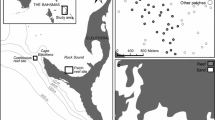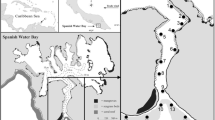Abstract
Movement of coral reef fishes across marine reserve boundaries subsequent to their initial settlement from the plankton will affect the ability of no-take reserves to conserve stocks and to benefit adjacent fisheries. However, the mobility of most exploited reef species is poorly known. We tagged 1443 individuals of 35 reef fish species captured in Antillean fish traps in the Barbados Marine Reserve and adjacent non-reserve over a two-month period. Trapping and visual surveys were used to monitor the movements of these fish during the trapping period and the subsequent two months. Estimates of distances moved were corrected for the spatial distribution of sampling effort and for the number of recaptures of individual fish. Recapture rates for individual species ranged from 0–100% (median=38%). Species mobility estimated by recapture and resighting were highly correlated. Most species were strongly site attached, with the majority of recaptures and resightings occurring at the site of tagging. However, only one of 59 tagged jacks (Caranx latus, C. ruber) was ever resighted, suggesting emigration from the study area. All species were occasionally recorded away from the sites where they had been tagged (20–500 m), and several species, including surgeonfish, Acanthurus bahianus, A. coeruleus, filefish, Cantherhines pullus, butterflyfish, Chaetodon striatus, angelfish Holocanthus tricolor and parrotfish, Sparisoma viride, ranged widely within reefs. In contrast, few movements were observed between reefs separated by more than 20 m of sand and rubble, and no emigration from the Reserve was recorded. Most reef fishes vulnerable to Antillean traps appear sufficiently site-attached to benefit from reserves. However, many species move over a wide enough area to take them out of small reserves on continuous reef. Use of natural home range boundaries could minimize exposure of fishes in reserves to mortality from adjacent fisheries.
Similar content being viewed by others
References cited
Aguilar-Perera, A. & W. Aguilar-Dàvila. 1996. A spawning aggregation of Nassau grouper Epinephelus striatus (Pisces: Serranidae) in the Mexican Caribbean. Env. Biol. Fish. 45: 351–361.
Alcala, A.C. & G.R. Russ. 1990. Adirect test of the effects of protective management on abundance and yield of tropical marine resources. J. Cons. int. Explor. Mer 46: 40–47.
Attwood, C.G. & B.A. Bennett. 1994. Variation in dispersal of galjoen (Coracinus capensis) from a marine reserve. Can. J. Fish. Aquat. Sci. 51: 1247–1257.
Baker, M., N. Nur & G.R. Geupel. 1995. Correcting biased estimates of dispersal and survival due to limited study area: theory and an application using wrentits. Condor 97: 663–674.
Bardach, J.E. 1958. On the movements of certain Bermuda reef fishes. Ecology 39: 139–146.
Barrowclough, G.F. 1978. Sampling bias in dispersal studies based on finite area. Bird-Banding 49: 333–341.
Bartels, P.J. 1984. Extra-territorial movements of a perennially territorial damselfish, Eupomacentrus dorsopunicans Poey. Behaviour 91: 312–321.
Burke, N. 1995. Nocturnal foraging habitats of French and bluestriped grunts, Haemulon flavolineatum and H. sciurus, at Tobacco Caye, Belize. Env. Biol. Fish. 42: 365–374.
Chapman, M.R. 1997. Coral reef fish movements and the effectiveness of the Barbados Marine Reserve. M.Sc. Thesis, McGill University, Montréal. 67 pp.
Chapman, M.R. & D.L. Kramer. 1999. Gradients in coral reef fish density and size across the Barbados Marine Reserve boundary: effects of reserve protection and habitat characteristics. Mar. Ecol. Prog. Ser. (in press).
Corless, M., B.G. Hatcher,W. Hunte & S. Scott. 1998. Assessing the potential for fish migration from marine reserves to adjacent fished areas in the Soufriere Marine Management Area, St. Lucia. Proc. Gulf and Caribb. Fish. Inst. 49 (in press).
Doherty, P.J. 1983. Tropical territorial damselfishes: is density limited by aggression or recruitment? Ecology 64: 176–190.
Foster, S.A. 1985. Group foraging by a coral reef fish: a mechanism for gaining access to defended resources. Anim. Behav. 33: 782–792.
Hixon, M.A. & J.P. Beets. 1993. Predation, prey refuges, and the structure of coral-reef fish assemblages. Ecol. Monogr. 63: 77–101.
Hixon, M.A. & M.H. Carr. 1997. Synergistic predation, density dependence, and population regulation in marine fish. Science 277: 946–949.
Hobson, E.S. 1973. Diel feeding migrations in tropical reef fishes. Helgoländer wiss. Meeresunters. 24: 361–370.
Holland, K.N., J.D. Peterson, C.G. Lowe & B.M. Wetherbee. 1993. Movements, distribution and growth rates of the white goatfish Mulloides flavolineatus in a fisheries conservation zone. Bull. Mar. Sci. 52: 982–992.
Holland, K.N., C.G. Lowe & B.M. Wetherbee. 1996. Movements and dispersal patterns of blue trevally (Caranx melampygus) in a fisheries conservation zone. Fish. Res. 25: 279–292.
Johannes, R.E. 1981. Words of the lagoon. University of California Press, Berkeley. 245 pp.
Kramer, D.L. & M.R. Chapman. 1999. Implications of fish home range size and relocation for marine reserve function. Env. Biol. Fish. 55: 65–79.
Lawson, G.L., D.L. Kramer & W. Hunte. 1999. Size-related habitat use and schooling behavior in two species of surgeonfish (Acanthurus bahianus and A. coeruleus) on a fringing reef in Barbados, West Indies. Env. Biol. Fish. 54: 19–33.
Lewis, J.B. 1960. The coral reefs and coral communities of Barbados, W.I. Can. J. Zool. 38: 1133–1145.
Lirman, D. 1994. Ontogenetic shifts in habitat preferences in the three spot damselfish Stegastes planifrons (Cuvier), in Roatan Island, Honduras. J. Exp. Mar. Biol. Ecol. 180: 71–81.
Low, R.M. 1971. Interspecific territoriality in a pomacentrid reef fish, Pomacentrus flavicauda Whitley. Ecology 52: 649–654.
Luckhurst, B.E. & K. Luckhurst. 1978. Diurnal space utilization in coral reef fish communities. Mar. Biol. (Berl.) 49: 325–332.
McAfee, S.T. & S.G. Morgan. 1996. Resource use by five sympatric parrotfishes in the San Blas Archipelago, Panama. Mar. Biol. 125: 427–437.
Ogden, J.C. & P.R. Ehrlich. 1977. The behavior of heterotypic resting schools of juvenile grunts (Pomadasyidae). Mar. Biol. 42: 273–280.
Ogden, J.C. & T.P. Quinn. 1984. Migration in coral reef fishes: ecological significance and orientation mechanisms. pp. 293–308. In: J.D. McCleave, G.P. Arnold, J.J. Dodson & W.H. Neill (ed.) Mechanisms of Migration in Fishes, Plenum Press, New York.
Rakitin, A. 1994. The effect of a marine reserve on the abundance and size of coral reef fishes in Barbados, West Indies. M.Sc. Thesis, McGill University, Montréal. 80 pp.
Rakitin, A. & D.L. Kramer. 1996. Effect of a marine reserve on the distribution of coral reef fishes in Barbados. Mar. Ecol. Prog. Ser. 131: 97–113.
Randall, J.E. 1962. Tagging reef fishes in the Virgin Islands. Proc. Gulf Caribb. Fish. Inst. 14: 201–241.
Reese, E.S. 1973. Duration of residence by coral reef fishes on 'home' reefs. Copeia 1973: 145–149.
Roberts, C.M. & N.V.C. Polunin. 1991. Are marine reserves effective in management of reef fisheries? Rev. Fish Biol. Fish. 1: 65–91.
Robertson, D.R. 1988. Abundances of surgeonfishes on patch-reefs in Caribbean Panama: due to settlement, or post-settlement events? Mar. Biol. 97: 495–501.
Robertson, D.R., D.G. Green & B.C. Victor. 1979. The behavioral ecology of three Indian Ocean surgeonfishes (Acanthurus lineatus, A. leucosternon and Zebrasoma scopas): their feeding strategies, and social and mating systems. Env. Biol. Fish. 4: 125–170.
Rowley, R.J. 1994. Marine reserves in fishery management. Aquatic Conservation: Marine and Freshwater Ecosystems 4: 233–254.
Russ, G.R. 1985. Effects of protective management on coral reef fishes in the central Philippines. Proc. 5th Int. Coral Reef Congr. 4: 219–224.
Russ G.R. & A.C. Alcala. 1996. Do marine reserves export adult fish biomass? Evidence from Apo Island, central Philippines. Mar. Ecol. Prog. Ser. 132: 1–9.
Sale, P.F. 1978. Reef fishes and other vertebrates: a comparison of social structures. pp. 313–346. In: E.S. Reese & F.J. Lighter (ed.) Contrasts in Behavior: Adaptations in the Aquatic and Terrestrial Environments, Wiley, New York.
Sale, P.F. 1991. Introduction. pp. 3–15. In: P.F. Sale (ed.) The Ecology of Fishes on Coral Reefs, Academic Press, San Diego.
Sladek Nowlis, J. & C.M. Roberts. 1997. You can have your fish and eat it, too: theoretical approaches to marine reserve design. Proc. 8th Int. Coral Reef Symp. 2: 1907–1910.
Smith, C.L. & J.C. Tyler. 1972. Space resource sharing in a coral reef fish community. Bull. Nat. Hist. Mus. Los Ang. City 14: 125–170.
Stamps, J.A., M. Buechner & V.V. Krishnan. 1987. The effects of edge permeability and habitat geometry on emigration from patches of habitat. Amer. Nat. 129: 533–552.
Stearn, C.W., T.P. Scoffin & W. Martindale. 1977. Calcium carbonate budget of a fringing reef on the west coast of Barbados: part I-zonation and productivity. Bull. Mar. Sci. 27: 479–510.
van Rooij, J.M., F.J. Kroon & J.J. Videler. 1996. The social and mating system of the herbivorous reef fish Sparisoma viride: one-male versus multi-male groups. Env. Biol. Fish. 47: 353–378.
Warner, R.R. & S.G. Hoffman. 1980. Population density and the economics of territorial defense in a coral reef fish. Ecology 61: 771–780.
Warner, R.R. 1995. Large mating aggregations and daily long-distance spawning migrations in the bluehead wrasse, Thalassoma bifasciatum. Env. Biol. Fish. 44: 337–345.
Zeller, D.C. 1997. Home range and activity patterns of the coral trout Plectropomus leopardus (Serranidae). Mar. Ecol. Prog. Ser. 154: 65–77.
Author information
Authors and Affiliations
Rights and permissions
About this article
Cite this article
Chapman, M.R., Kramer, D.L. Movements of Fishes Within and Among Fringing Coral Reefs in Barbados. Environmental Biology of Fishes 57, 11–24 (2000). https://doi.org/10.1023/A:1004545724503
Issue Date:
DOI: https://doi.org/10.1023/A:1004545724503




